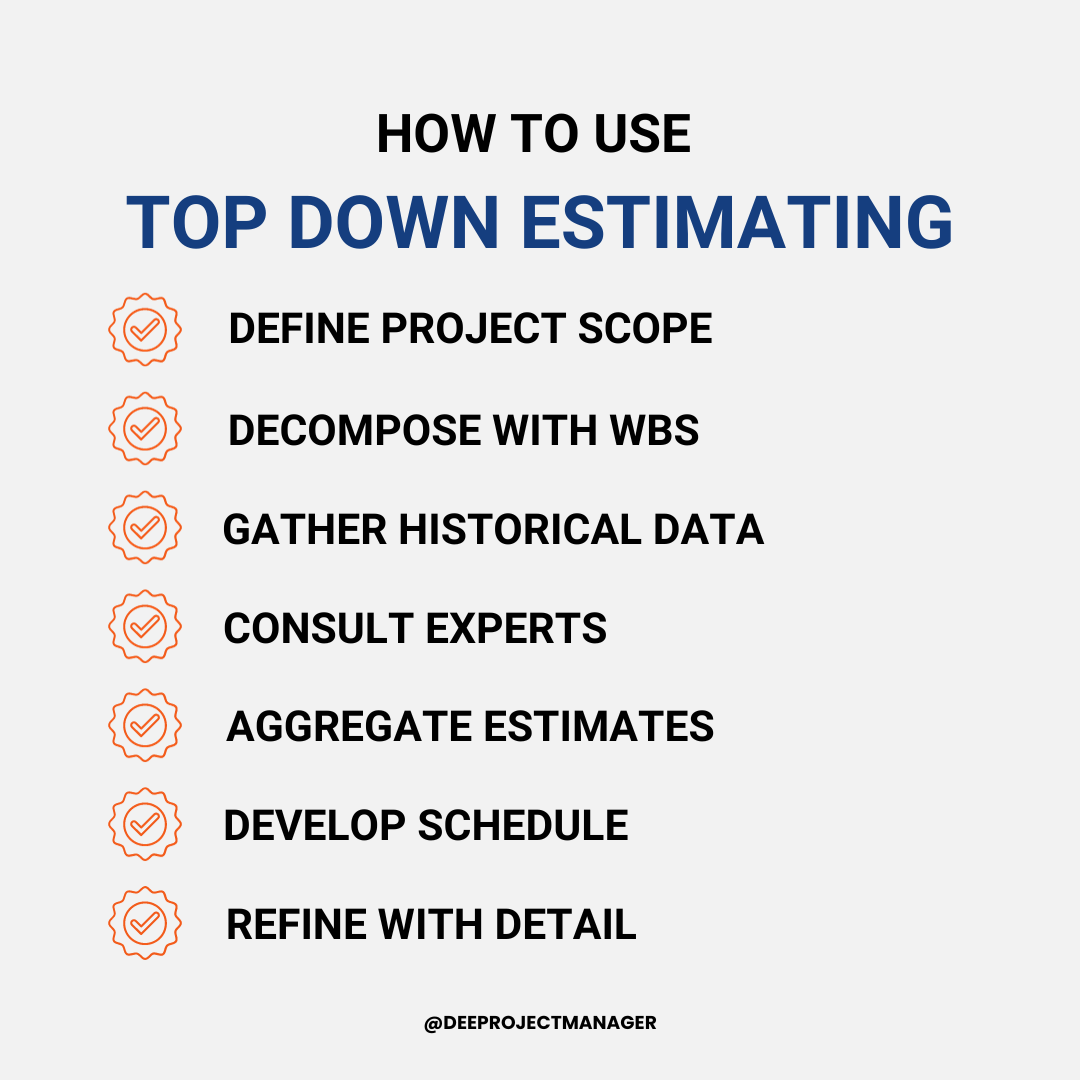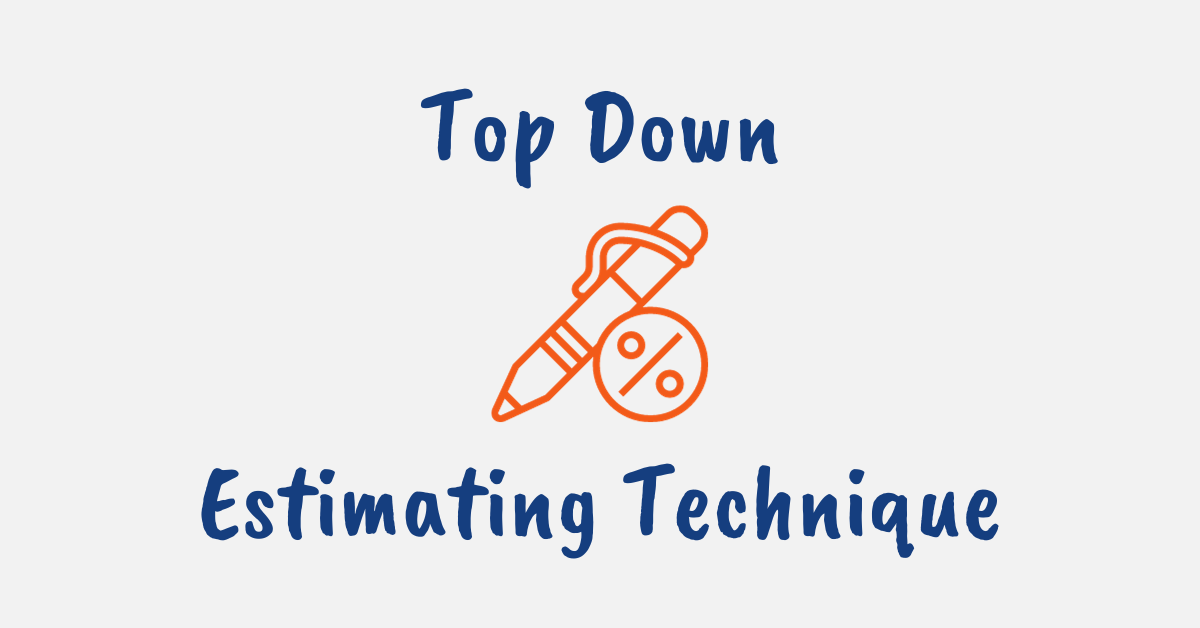Developing accurate estimates for project activities including duration, costs, and resource requirements is key to effective planning and management.
While there are various techniques, top down estimating provides a valuable approach, especially during the initial planning stages.
This method leverages expert judgment and historical data to quickly forecast total project costs without having to do detailed time-consuming analysis.
In this article, we’ll cover what top down estimating entails, as well as how to use it to effectively plan project budgets and timelines.
What is Top Down Estimating?
Top down estimating is a method used to forecast the total expected cost and duration of a project during the initial planning stages before detailed requirements and tasks are known.
With top down estimating, the total budget is estimated first by examining the high-level project scope and leveraging historical data from similar past projects.
Subject matter experts provide their judgment on the overall timeline and cost based on experience.
Once the total budget is determined, it is then broken down into lower-level work packages. More analysis happens later to refine the estimates for each package.
However, the initial ballpark total provides an early snapshot of budget and timeline expectations.
Top down estimating relies on expert input and historical data rather than a detailed bottom up analysis of each task providing a quick, top-level view to support initial planning and decision making when project specifics are uncertain.

When to Use Top Down Estimating
Top down estimating is best leveraged in certain situations when you need a quick, high-level estimate rather than granular details.
It gives just enough data to support initial planning and decisions needed to keep the project moving forward towards a more thorough estimate.
Key times when top down estimating is applicable include:
- During project initiation when requirements are unclear. A rough order of magnitude for budget and timeline is needed for approval and planning.
- When assessing the viability of a new product or project. It enables the stakeholders to forecast costs based on past data to determine if the project should progress.
- When evaluating different project alternatives, top down estimates allow quick comparisons between options.
- For concept development of new technologies where specifics are unknown. Past prototypes can provide data to estimate budgets.
- When resources are limited. The faster top down method requires fewer team members than detailed bottom up estimating.
- When minimal risks or uncertainties are expected. More uncertainty calls for more detailed bottom up estimates.
- For high-level portfolio planning and scheduling multiple projects using limited details.

How to Use Top Down Estimating
By following some key steps, you can effectively create a top down estimate:
1. Define Project Scope and Objectives
First, clearly identify the goals, deliverables, and requirements that outline the overall scope of the project to provide the framework.
2. Break Down Using a Work Breakdown Structure
Next, decompose the project down into major phases or functional areas using a work breakdown structure (WBS). The WBS divides the project into more manageable chunks.
3. Gather Historical Data
Leverage data from past projects of similar size and scope. Use the actual costs and timelines as a baseline, adjusting for any differences.
4. Consult Experts
Have experts like senior managers provide estimates per phase based on past experience, and combine them with historical data.
5. Aggregate Estimates
Add up the estimates from historical data and experts to determine the total expected budget and duration. Identify contingencies.
6. Develop Schedule
Map out major milestones and phases in a master schedule showing the sequence of work.
7. Refine with Detail
Use the top down estimate to guide more detailed planning as the project evolves.
Top Down Estimating Techniques
Some top down estimating techniques are:
Analogous Estimating
Analogous estimating uses the actual costs and timelines from previous, similar projects as the basis for estimating the current project.
It relies on the historical data from past projects being fairly accurate and comparable.
The estimated cost is determined by adjusting the historical data to account for differences in scope, scale, or requirements.
Parametric Estimating
Parametric estimating uses statistical modeling to define the relationship between cost and project parameters like scope, size, complexity, etc. Historical data is used to develop the model.
Cost-estimating relationships and models are derived by analyzing past costs and project metrics.
These models can then estimate costs for new projects based on planned project parameters as inputs.
Expert Judgment
Leveraging input from experts like project managers, architects, and senior technical leads is commonly used in top down estimating.
These experts can provide estimates for costs, timelines, and budgets for each phase or deliverable based on their experience and knowledge. Multiple expert estimates may be aggregated.
Three-Point Estimating
A simplified form of three-point estimating can be used to provide not just a cost estimate but also a range with upside and downside figures.
This provides contingency buffers which are helpful given the uncertainty with top-down estimates.
Using a blend of these methods allows you as a project manager to develop an accurate high-level view of the overall project cost and timeline for initial planning and approvals.

Top-Down Estimating Methods
There are a few specific methods commonly used for top-down estimating:
Consensus Estimating
With this approach, several project managers or experts each provide an individual estimate for the total project cost and duration.
Then all the experts discuss and reach an agreement on a final consensus estimate to use. This allows multiple perspectives to factor in.
Ratio Estimating
For ratio estimating, standardized metrics are used to derive the estimates. For example, historical data can provide ratios like cost per square foot for construction projects.
This ratio is then applied to the known square footage of the new project to estimate costs.
Ratios based on parameters like per unit, per kilometer, per resource hour, or per feature can be leveraged in estimating.
Apportionment
The apportionment method first defines the total budget. Then subject matter experts estimate what percentage of the total budget specific project components will consume based on experience.
For example, materials may be estimated at 50% of total costs while labor is 25%. This apportions the budget across all planned elements.
Leveraging a combination of these top down estimating methods allows project managers to quickly forecast budget numbers during the initiation and planning processes to support project approvals and funding.
The estimates can be refined later as the project progresses.

Pros and Cons of Top Down Estimating Technique
Top down estimating has both advantages and disadvantages compared to other estimating approaches like bottom-up estimating.
Understanding these pros and cons will help you determine when to use top down estimating versus other estimating techniques based on the project situation and the required accuracy of estimates.
Advantages of Top Down Estimating
- It provides estimates quickly with minimal effort since detailed, granular analysis is not required.
- It allows high-level budgeting and planning when the project scope is unclear and details are uncertain.
- It’s a good method for assessing project feasibility and making go/no-go decisions for new initiatives.
- It leverages expertise from project managers which accounts for risks and execution factors an estimate based purely on task hours may miss.
- It considers the project as a whole first before breaking it down into components. Aligns well with how projects are managed.
- Estimates from the top-down method are somewhat flexible early on since precision is not expected initially. As more details emerge, the estimates can be refined.
- It works well for getting approval and funding commitment upfront before deep analysis is undertaken.
Disadvantages of Top Down Estimating
- It is less accurate than bottom up estimating since it is not based on task-level details and can miss costs associated with lower-level activities.
- Its top-down nature makes it difficult for project team members to provide input into the estimate creation process.
- It is heavily dependent on expert judgment which can introduce bias or human error if historical data is not also leveraged.
- It is not easily repeatable as it relies more on subjective human input than process rigor and metrics.
- It can set unrealistic stakeholder expectations if presented as the final estimate without explaining it is a rough initial estimate.
Top Down Estimating Example
Let’s walk through an example of leveraging top down estimating for a project to build a new bridge.
First, the lead engineer and project sponsor define the overall scope: a 2 km bridge spanning a river, supporting 4 vehicle lanes and 2 pedestrian lanes.
Next, historical data is gathered from past comparable bridge projects showing $15 million per km in total costs.
The lead engineer provides an estimate of $35 million total for this 2 km bridge based on expertise from building bridges of similar scale.
The project sponsor also consults an outside firm that estimates the bridge will take 18 months to construct based on the requirements.
Combining these expert judgments and historical data, the total project cost is estimated at $35 million over an 18-month schedule. A 10% contingency reserve is added.
This top down estimate is used to determine project viability and make the decision to proceed to more detailed planning.
Detailed cost and schedule estimates will be developed for each phase like foundations, substructure, superstructure, and completion.
But starting with the high-level top down estimate provides an initial snapshot to guide the process.
The key is leveraging different inputs and viewpoints to reach an initial rough order of magnitude without exhaustive bottom-up analysis.
What is Top Down Estimation in Agile?
Top down estimating can also be applied on Agile software development projects, though some modifications are required.
At the beginning of an Agile project, the Product Owner often has a high-level vision and set of features in mind but limited details.
The Project Lead can work with the Product Owner to come up with a rough order of magnitude estimate for the full features list based on experience with similar past projects.
This provides a top down budget estimate even with some uncertainty upfront.
As Agile teams progress Sprint-by-Sprint and gain insights about user stories and tasks, the top-down estimate can be refined into more precise bottom-up estimates each Sprint.
The cyclical Agile process allows for regular estimation adjustments not possible in traditional waterfall development.
While less prescribed, top-down estimating gives Agile teams a valuable starting point for initial planning and funding requests.

Top Down Estimating vs Bottom Up Estimating Comparison
Top down estimating and bottom up estimating represent two different approaches to forecasting project costs and timelines, each with pros and cons.
Let’s compare them head-to-head to fully understand how they differ:
Estimating Approach
The top down approach starts by estimating the total budget for the entire project first.
Subject matter experts examine the high-level scope and leverage data from similar historical projects to derive a rough order of magnitude for cost and timeline.
In contrast, bottom up estimating starts at the ground level by estimating the hours, resources, and costs associated with every minor task and deliverable.
These are rolled up into the major work packages, components, and finally the entire project.
Planning Stages Used
Top down estimating is best leveraged in the early stages of project planning when detailed requirements are not yet available.
It provides a quick, high-level estimate to support initial decision-making on project viability, budgeting, and scheduling.
Bottom up estimating on the other hand is more applicable later in the planning process once the project scope and requirements are clearer.
It involves a detailed analysis of all the granular components to arrive at a more precise estimate.
Time and Effort Needed
Top down estimating requires less time and effort from project teams than bottom up as it relies more on expert judgment and historical analogues rather than requiring project teams to estimate each low-level item.
Bottom up estimating demands extensive analysis of all the detailed project components and tasks.
Effort is needed from each specialty team to estimate at a granular level which makes it more time-consuming.
Team Member Involvement
Top down estimating is driven primarily by leadership like project sponsors, managers, architects, and subject matter experts. The wider project team provides less input.
For bottom up estimating, participation is needed from team members across all roles to analyze and estimate their respective components and tasks. The estimate synthesis incorporates all viewpoints.
Accuracy
Bottom up estimates are inherently more accurate than top down estimates because they are based on project specifics rather than historical assumptions. However, they may still contain uncertainty.
Top down estimates provide a ballpark figure but lack precision since they are derived from previous project benchmarks, analogous data, and expert judgment instead of detailed analysis.
In reality, most projects use a bit of both techniques. Top down provides a solid starting point for approval, while bottom up refines and replaces those estimates as the project moves forward allowing increased efficiency in project estimation processes.

Top Down Estimating PMP Exam Tips
If you are aspiring for a PMP certification, understanding top down estimating is key for the exam preparation as it relates to the Project Cost Management knowledge area and you can expect a few questions from the topic.
On the exam, expect situational questions asking when top down estimating is most applicable. It is best used early in the project during initiation and planning when details are unclear.
Compare top down vs bottom up estimating. Know that top down provides a quick, high-level estimate by senior experts, while bottom-up offers more precision from detailed analysis.
Be prepared to identify the pros and cons of top down estimating. Know it is faster but less accurate.
You may also see questions on specific top down techniques like analogous, parametric, and three-point estimating.
Getting familiar with the key aspects of top down estimating will help you successfully answer PMP exam questions and showcase your expertise in project cost estimations.
Also, review the inputs, tools/techniques, and outputs of the Estimate Costs process.
Final Thoughts
Effective project management requires a knowledge of how to accurately estimate cost, resources, and timelines of project activities and tasks.
The top down estimating technique is valuable for forecasting high-level budget and timeline expectations, especially when project details are uncertain.
By leveraging historical data, expert judgment, and proven methods, you can quickly derive a rough order of magnitude using top down techniques.
While it’s less precise than bottom up estimating, a top down estimate delivers the high-level overview needed for upfront decision-making.
Top Down Estimating FAQs
Is Top-down or Bottom Up Estimating more Accurate?
Bottom-up estimating is generally more accurate as it involves detailed analysis of each task. However, it’s time-consuming.
Top-down estimating is quicker but can be less accurate as it relies on overall project or phase estimates, not individual task details.
When is the Top-down Approach most Appropriate?
The top-down approach is most appropriate during the early stages of a project when high-level strategic decisions are made, or when there is limited detailed information about individual tasks but an overall view of the project is available.
Why is Top Down Estimating Generally Not Effective at Developing a Low Cost Project Estimate?
Top-down estimating, being a high-level approach, may overlook detailed task-level complexities and resource needs, potentially leading to underestimation of costs.
It’s generally less effective for developing a low-cost project estimate due to its lack of granularity.
Which Type of Project Lends Itself to the Function Point Method of Top Down Estimating?
The Function Point method of top-down estimating is particularly relevant for software and system development projects, where the project’s complexity and functionality can be quantified and used to estimate effort and cost.
Is Parametric Estimating Top Down?
Yes, parametric estimating is a type of top-down estimating. It uses statistical modeling and historical data to calculate cost and duration estimates based on project parameters like size, weight, or complexity.





